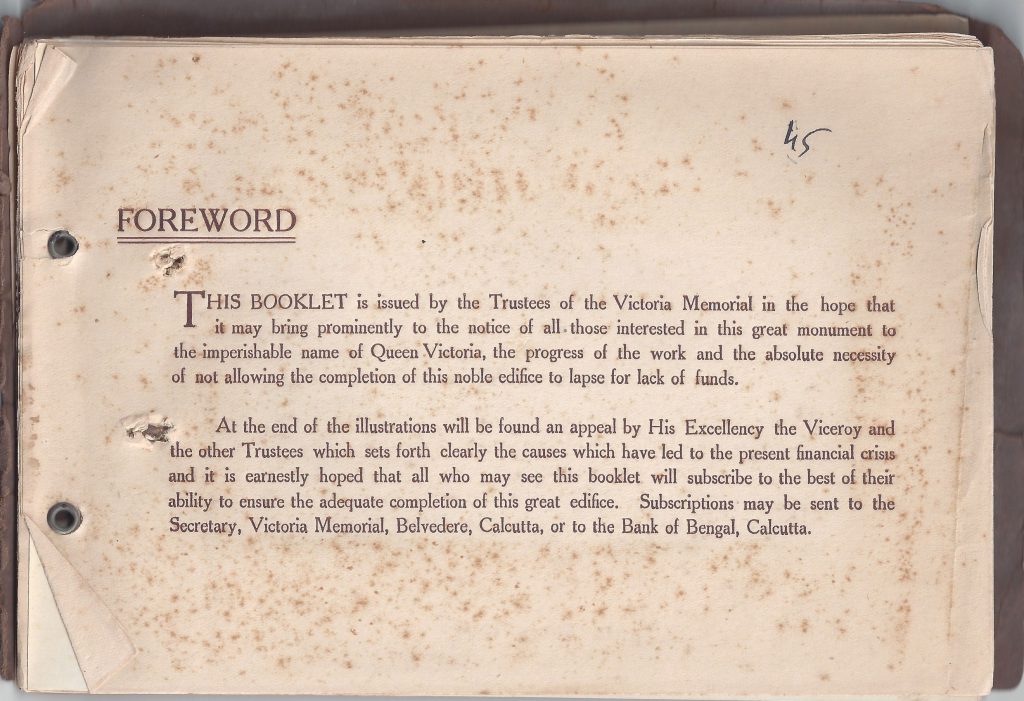The Construction of the Great Queen Victoria Memorial in Calcutta, Symbol of an Empire: The Archive of a Maharaja












Including the Maharaja's copy of a rare set of photographs of the construction and plans of the Memorial
Letters of 2 other Maharajas and prominent Indian leaders
In January 1901, on the death of Queen Victoria, the Lord Curzon of Kedleston, then Viceroy of India, suggested the creation of a memorial. Curzon proposed the construction of a grand building with a museum and gardens, saying,”Let us, therefore, have a building,...
Letters of 2 other Maharajas and prominent Indian leaders
In January 1901, on the death of Queen Victoria, the Lord Curzon of Kedleston, then Viceroy of India, suggested the creation of a memorial. Curzon proposed the construction of a grand building with a museum and gardens, saying,”Let us, therefore, have a building, stately, spacious, monumental and grand, to which every newcomer in Calcutta will turn, to which all the resident population, European and Native, will flock, where all classes will learn the lessons of history, and see revived before their eyes the marvels of the past.” The Prince of Wales, later King George V, laid the foundation stone on January 4, 1906, and it was formally opened to the public in 1921.
The Victoria Memorial was funded by Indian states, individuals of the British Raj and the British government in London. The princes and people of India responded generously to Lord Curzon’s appeal for funds.
Bhagvatsinhji was the ruling Maharaja of the princely state of Gondal from 1869, when he was a boy, until his death in 1944. He was the only Maharaja to take a medical degree. He also corresponded with the men in charge of funding the memorial. This is his retained archive and collection, showing the effort India-wide to create a lasting memorial to Queen Victoria.
The Archive:
The archive consists of 24 documents, including:
The Maharaja’s personal copy of “The All Indian Victoria Memorial” at Calcutta: Johnson & Hoffmann, photographers, early 20th century. It contains photographs of the construction and finished monument of the Victoria Memorial. We have only found one other copy of this having reached the market, and that in 2012.
The 1903 printed report of the Queen Victoria Memorial Fund, the only one we have found offered for sale. The document, dated March 20, 1903, 8 pages, is an early Report of the Queen Victoria Memorial Fund, showing India-wide subscriptions and the status of fund raising for the statue of India. Signed in type by Chairman of the Committee P. Playfair.
The above includes a separate document of the same date with the “State of Accounts” of the Fund, listing the finances of the group, signed in type by Committee Secretary W.W. Cunningham.
The list of subscribers the year the monument opened, prepared at the request of the Maharaja, signed by the Committee Secretary, H. Dass. It includes the amount they gave. Document signed, by Dass, May 15, 1921, along with the letter from the office of the Maharaja requesting it, and Dass’s letter sending it.
The Maharaja’s receipt for his donation of 2,000 rupees: Document signed, April 27, 1921, by Committee Secretary H. Dass, being the Maharaja’s receipt for the above donation, along with a typed letter signed, from the Fund committee, John Wood, April 12, 1921, to the Maharaja, receiving his pledge.
Correspondence of Prominent Indians, including other Maharajas:
Sir Dinshaw Edulji Wacha was one of the founding members of the Indian National Congress. 3 rare Autograph letters signed of Wacha, to the Maharaja, relating to the building of the Memorial and the subscription of funds.
Typed letter signed, Maharaja Ganga Singh, to the Maharaja at Gondol, December 21, 1921, enclosing the below, and writing “It is unnecessary for me to dwell at great length on the extreme desirability of our coming to the rescue and showing once again a practical proof of the high veneration and affection in which Queen Victoria’s name is held by us and our people.” Also document, signed in type by Ganga Singh, Maharaja of Bikaner, Chancellor, Chamber of Princes, November 27, 1921, asking the Maharaja recipient to donate. “The name Queen Victoria is a household word.”
Daulat Singh was the Maharaja of Idar from 1911 to 1931.Typed letter signed, Daulat Singhji, March 7, 1921, to Gondol. “No action has yet been taken by the State regarding the appeal for contributions to the funds of the All India Queen Victoria Memorial received through the Honorable Sir John Wood. The memorial being out of our Presidency, it was remarked by some of the Kathiasawr Princes in Delhi that it was not necessary to give anything, but we are waiting to see what other Princes do in the matter.”

Frame, Display, Preserve
Each frame is custom constructed, using only proper museum archival materials. This includes:The finest frames, tailored to match the document you have chosen. These can period style, antiqued, gilded, wood, etc. Fabric mats, including silk and satin, as well as museum mat board with hand painted bevels. Attachment of the document to the matting to ensure its protection. This "hinging" is done according to archival standards. Protective "glass," or Tru Vue Optium Acrylic glazing, which is shatter resistant, 99% UV protective, and anti-reflective. You benefit from our decades of experience in designing and creating beautiful, compelling, and protective framed historical documents.
Learn more about our Framing Services



















































































































